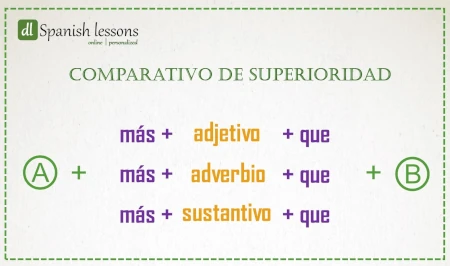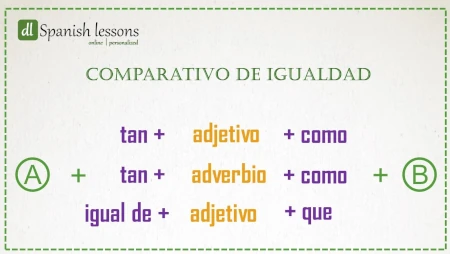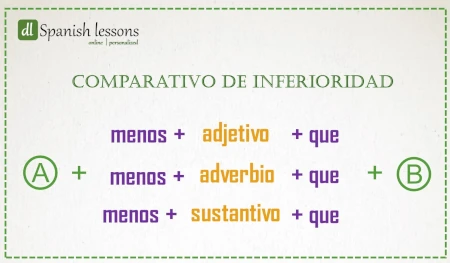✎ Video lesson + interactive exercises (see below)
The comparative has various structures with which you can compare two or more things. For example, to explain: A car is faster than a bike.
The comparative is divided into three forms: the comparative of superiority, the comparative of equality and the comparative of inferiority.
In this entry, we’ll have a look at how to form these three structures. Let’s begin with the comparative of superiority.
The comparative of superiority (Comparativo de superioridad)

The comparative of superiority has the following structure:
A) Let’s begin with the first structure “más+adjective+que”. An example sentence would be:
✎ María es más inteligente que Ana. (María is more intelligent than Ana.)
Here you can see that we are comparing two things (persons), María and Ana. As you can see, we used the verb “ser”. For this comparison, we always use either the verb “ser” or “estar”. Here an example with “estar”:
✎ María está más cansada que Ana. (María is more tired than Ana.)
You have to choose between the verb “ser” and “estar”, as well as between singular and plural, depending on the subject of the sentence.
B) Let’s continue with the second structure “más+adverb+que” and an example being:
✎ María escribe más lentamente que Ana. (María writes slower than Ana.)
Here again, we are comparing two things (persons), though in this case we don’t use the verb “ser/estar” but any other verb.
C) And we finish with the third structure “más+noun+que”. Here an example:
✎ María escribe más frases que Ana. (María writes more sentences than Ana.)
Here we compare again two things (persons) and here we can also use any verb other than “ser/estar”.
Let’s go on with the next structure.
The comparative of equality (El comparativo de igualdad)

The comparative of equality has the following structures:
A) Let’s begin with the first one “tan+adjective+como” again with an example sentence with María and Ana:
✎ María es tan inteligente como Ana. (María is as intelligent as Ana.)
Here, once again, you can see that we compare two things (persons). And again we use the verb “ser/estar”. Here an example with “estar”, this time in plural:
✎ María y su hermana están tan cansadas como Ana. (María and her sister are as tired as Ana.)
Using the verb in the third-person plural, we have to adapt the adjective, i.e. use it in plural as well.
B) Let’s continue with the structure “tan+adverb+como”. Here an example:
✎ María escribe tan lentamente como Ana. (María writes as slow as Ana.)
In this case, we don’t use the verb “ser/estar” but any other verb.
C) And we finish with the third structure “igual de+adjective+que”:
✎ María escribe frases igual de rápido que Ana. (María writes sentences as fast as Ana.)
In this case we don’t use the verb “ser/estar” but any other verb.
The comparative of inferiority (El comparativo de inferioridad)

This comparative has the following structures:
A) We begin with the structure “menos+adjective+que”. An example:
✎ Mis amigos son menos simpáticos que Ana y su hermana. (My friends are less likable than Ana and her sister.)
Here you can see that we compare more than two persons (things) and therefore we use the verb in plural and we write the adjective in masculine/plural. You have to pay attention to that they match in all the structures of the comparative. As you can see, we used once more the verb “ser”. For this comparison, we always use either the verb “ser” or “estar”. Here an example with “estar”:
✎ María está menos interesada que Ana en el curso. (María is less interested in the course than Ana.)
B) We continue with the structure “menos+adverb+que”. For example:
✎ María escribe menos rápidamente que Ana durante el dictado. (María writes less fast during the dictation than Ana.)
As in the cases before, we don’t use the verb “ser/estar” but any other verb.
C) We finish with the third structure “menos+ noun+que”:
✎ María escribe menos frases que Ana durante el mismo tiempo. (María writes fewer sentences than Ana in the same time.)
Here, the same as in section 2, we compare two things (persons) and we can use any verb other than “ser/estar”.
These are the most important structures for the levels A1 and A2. With them, you can express differences between two or more things very good. Of course, these structures and cases extend in the next levels.
Below, you can find a video with the complete explanation.
Video lesson
Interactive exercises
Credits:
Featured image: dl Spanish lessons
Picture 01 – 03: dl Spanish lessons
